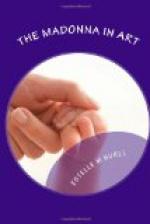It is of pictures like this that our poet Longfellow is speaking, when he thus apostrophizes the Virgin:
“Thou
peerless queen of air,
As sandals to thy feet the
silver moon dost wear.”
The enskied Madonna involves many technical difficulties of composition, and demands a high order of artistic imagination. It could hardly be called a frequent subject in the period of greatest artistic daring, and no modern painter has shown any adequate understanding of the subject, though there are not lacking those who have made the attempt. Bodenhausen, Defregger, Bouguereau, have all followed Raphael in representing the Queen of Heaven as a full-length figure in the sky; but their conception has not the dignity corresponding to the style of treatment.
Impatient and dissatisfied with such modern art, we turn back to the old masters with new appreciation of their great gifts.
CHAPTER IV.
THE PASTORAL MADONNA.
It was many centuries before art, at first devoted exclusively to figure painting, turned to the study of natural scenery. Thus it was that Madonna pictures, of various kinds, had long been established in popular favor before the idea of a landscape setting was introduced. We need not look for interesting pictures of this class before the latter part of the fifteenth century, and it was not until the sixteenth that the pastoral Madonna, in its highest form, was first produced. Even then there was no great number which show a really sympathetic love of nature.
In the ideal pastoral, the landscape entirely fills the picture, and the figures are, as it were, an integral part of it. Such pictures are so rare that we write in golden letters the names of the few who have given us these treasures.
Raphael’s justly comes first in the list. His earliest Madonnas show his love of natural scenery, in the charming glimpses of Umbrian landscape, which form the background. These are treated, as Muentz points out, with marked “simplicity of outline and breadth of design.” They are, however, but the beginning of the great things that were to follow. The young painter’s sojourn in Florence witnessed a marvellous development of his powers. Here he was surrounded by the greatest artists of his time, and he was quick to absorb into himself something of excellence from them all. His fertility of production was amazing. In a period of four years (1504-1508), interrupted by visits to Perugia and Urbino, he produced about twenty Madonnas, in which we may trace the new influences affecting him.
Leonardo da Vinci was, doubtless, his greatest inspiration, and it was from this master-student of nature that the young man learned, with new enthusiasm, the value of going directly to Nature herself. The fruit of this new study is a group of lovely pastoral Madonnas, which are entirely unique as Nature idyls. Three of these are among the world’s great favorites. They are, the Belle Jardiniere (The Beautiful Gardener), of the Louvre Gallery, Paris; the Madonna in Gruenen (The Madonna in the Meadow), in the Belvedere Gallery, Vienna; and the Cardellino Madonna (The Madonna of the Goldfinch), of the Uffizi, Florence.




